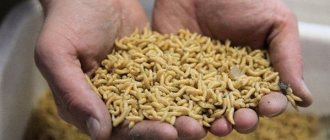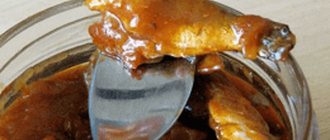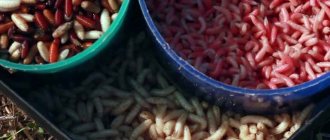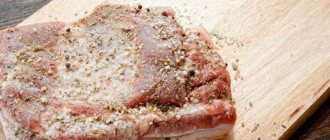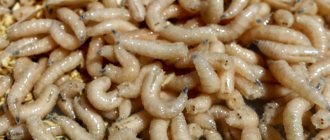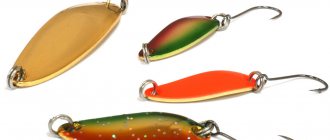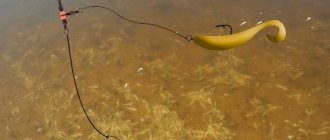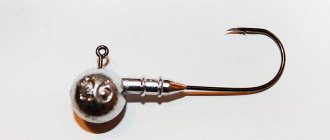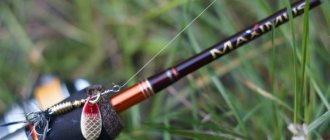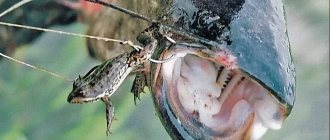Types of maggots
Visually, these larvae can be divided into three types:
The smallest maggots
They are also called kicks. Their body length reaches a maximum of 1 cm.
A distinctive feature of this type is its mobility and shelf life.
Pinks can be stored for 6 months. This species cannot swim and pupates slower than others, which is also an advantage for fishermen.
They are used as the main bait, added to balls when fishing with a float rod and to feeders when fishing with feeders.
Medium sized maggots
Their length is about 1.5 cm. Most often, this type of bait is added to groundbait.
As for shelf life, it is significantly shorter than that of their smaller counterparts.
These larvae can exist quietly in the refrigerator for a maximum of 20-25 days.
Due to the fact that the skin of this type of maggots is thicker, they can be attached to hooks.
The largest maggots
The length of individuals of this species can reach 2 and a half cm. They fit on a hook more conveniently than others. You can catch a good catch with this bait.
For example, white bream, carp, bream and crucian carp bite on large maggots. The disadvantages of such bait include the short life of the larvae.
In a warm place they pupate literally within a day.
If the larvae are kept cool, they can live in this form for about 10 days, maximum 2 weeks.
Not only live larvae are used in fishing. Pupated individuals are also relevant.
They attract mainly large fish.
In addition to bait, such maggots also serve as the main bait, which is often supplemented with live specimens.
Fishermen have even gotten used to using artificial maggots.
There are plenty of them on the shelves of fishing stores.
Such baits are made from silicone, then painted in colors attractive to fish and supplemented with a variety of flavors.
Why cook maggot?
It seems like there’s no point in bothering and boiling maggots when it’s already quite lively, which means the moving bait “works” and attracts the attention of the fish much better. But, as practice shows when fishing for bream, roach and even crucian carp, this is only partly true.
In the proposed design, at a minimum, the traditional maggot bait is transformed into a completely different catchable bait, which is capable of activating a fading bite.
Moreover, boiled maggot “works” effectively both on summer fishing trips using float or bottom gear, and on winter fishing trips using a jig or gullet. How can this be? Obviously, the mobility of the bait is not the key to success. The taste of the bait also plays an important role.
Boiled maggot is much more attractive to fish in its appearance and taste.
Boiled larvae are most likely much better. If boiled maggots are inferior in bait mobility, they are superior to live larvae in aroma and taste. I was especially impressed by boiled maggots during winter fishing, when they helped to renew the bite when neither the raspberries nor the live larvae worked.
Although, convincing new or “experienced” fishermen is not a very rewarding task. This article is a desire to share with readers an independent and effective attachment that can help out and activate the bite.
How to cook maggot
It is best to boil clean store-bought larvae. They just need to be selected from the sawdust and put into boiling water, where they should cook for 3 - 4 minutes. Some of the larvae will sink to the bottom, while others will remain floating on the surface. The latter will not work as attachments (they can be added to complementary foods). We remove the floating maggots, and filter the rest of the contents through a rag, wait until all the water has drained and then season the larvae a little with sunflower oil.
Boiled maggot is ready for its purpose. Store boiled larvae in the refrigerator.
Boiled maggots have a more intense color, which means they will better attract fish, and sunflower oil will not only add an attractive aroma, but will also prevent the larvae from sticking together.
For boiled maggots
How to hook
It is best to attach boiled maggots by piercing the larva in the middle, 5 to 10 pieces on one hook.
PS It is best to cook larvae in some unnecessary container (tin can) without using the pan in which the food is prepared.
Storing maggots in winter
Of course, if pupation occurs at this temperature, it is very slow, but there may not be enough bait for the whole winter. In addition, storing maggots in the refrigerator often causes protest from some household members, who (totally in vain) see this as a threat to their health.
In such cases, you can make a “refrigerator” for the maggot from a box in which bottles with ice are placed. Bottles are replaced as the ice melts. In winter, such a “refrigerator” is placed, for example, on the floor near the balcony door.
A cooler bag is also a good option. If the maggot storage temperature is not lower than 0 and not higher than +3, then in a state of suspended animation it will be stored for as long as desired, but will instantly come to life in your warm hands while fishing.
How to make boiled and pickled maggot?
Many fishermen have encountered this problem when, after many hours of fishing on a hot summer day, the maggot loses its mobility and gradually begins to pupate. For some reason, it is mistakenly believed that such maggots only deserve to be thrown away, since they are not suitable for fishing. But this is far from true; a “sluggish” maggot can be given another life by killing the larva (pardon the tautological pun). Below are some ways to do this.
Method 1. Making boiled maggot
The maggot is selected from the sawdust and placed in a free container, where it is laid out in one loose layer. Next, prepare salted water (1 tablespoon of salt per 200 milligrams of water) and bring it to a boil. Pour boiling water over the collected larvae, stirring them at the same time so that they are evenly scalded on all sides (the larvae will begin to float).
You don't need a lot of water, just enough to cover the larvae. After the water has cooled completely, remove the cooked larvae onto a napkin and dry them. The drying process is best done at room temperature for 2-3 hours so that the larva dries and becomes elastic. When drying larvae in an oven or on a hot radiator, make sure that the maggot does not dry out.
Boiled maggot is excellent for both summer and winter fishing, and also holds well on the hook. Another advantage of such bait is that it can be frozen and thawed several times and this will not affect its quality. Before re-freezing the maggot, it is a good idea to dry it again.
Method 2. Pickled maggot
This exotic method of preparing maggots was invented by English fishermen. As in the previous method, you can use “old” maggots that don’t quite move. Maggot larvae, cleared of sawdust and debris, are marinated in vinegar for 1 hour. After this, after rinsing and allowing the liquid to drain, dry it a little on a napkin. Next, the pickled maggot should be slightly fried in the microwave until firm and elastic.
Processing and preparing maggots for fishing
How to determine when buying fresh and not quite, already stale maggots and what is this for? In certain situations, it may be necessary to determine how long the larva remained on the store shelf before being sold and how soon it will pupate. This can be done simply by taking a quick glance at the nozzle. If the angler looks at it, fresh maggots have a black dot inside. She says that there is still food in the intestines and the maggot was recently removed from food. Such an ordinary maggot will lie in a warm place for 5-6 days, not pupating for up to 2-3 weeks. If there is no black dot, the bait has already lain for a decent time. If it has not even had time to decrease in size, then soon the process of pupation and transformation into a fly will inevitably begin.
Maggot with condensed milk is an excellent bait for successful fishing
We are talking about sweets that, as it turns out, are loved not only by children and adults, but also by fish. This is condensed milk - condensed milk!
With such milk, maggot becomes sweet and aromatic - something that is needed both for the fish and for us, fishermen.
For sweet maggots, you will need to dilute a few teaspoons of condensed milk in a glass of water. Shake until completely dissolved.
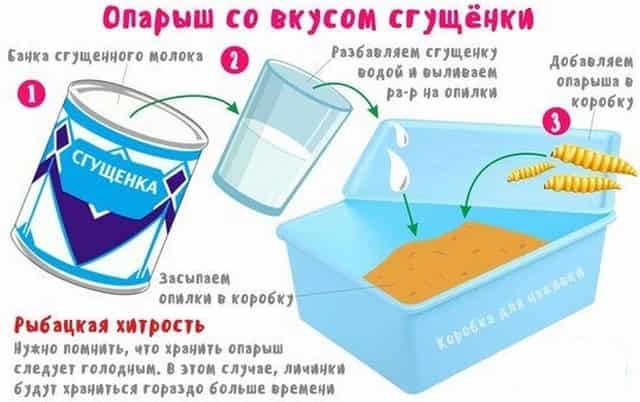
Then take sawdust and soak them in a milk solution for an hour.
Dry slightly if they are too wet. Because maggots do not like a lot of moisture.
Next, add our meat bait to the sawdust. If the maggot starts to burrow, it means you did everything right.
Useful and interesting: Country bait, which perfectly attracts fish in the fall - Zatarat "0" rubles!
Overnight the larvae will become sweet and aromatic. This will attract the fish more and tempt them to bite more often.
Even before fishing, it is worth feeding the place with groundbait, which includes the same maggots.
Try this meat bait with condensed milk and you will see how your fishing will liven up.
Attention! The daily norm can be achieved with such a nozzle within just the first few hours (or even earlier).
Flavoring maggots
There are both supporters of aromatization and its opponents.
Some believe that fish bite better on flavored larvae, while others advocate naturalness. Since the natural aroma of the larvae is the smell of rotten meat, it turns out that there is no need to clean the maggots?
But you must admit, even if the smell has absolutely no significance for the fish, it is much more pleasant for the fisherman to fish by placing clean, elastic larvae with the aroma of some vanilla on the hook.
The main method of changing the smell of maggots is to aromatize the sawdust in which it will be stored. They are sprayed with a ready-made flavoring agent with the desired smell.
Instead, you can add dried dill, garlic or other spices to the sawdust. Some fishermen boil sawdust along with spices and then dry them.
Storage
Important for storage will be some kind of container, which must be tightly sealed and without cracks. If the inner walls of the container are even a little wet, the larvae will quickly crawl along them to the surface and crawl away. And if the lid of the container is not secured tightly, the larvae can become food for rats, for whom they are considered a delicacy. The cracks will serve as a way out for the larvae to escape, since they can squeeze into even the smallest loophole, thanks to their extreme mobility and resourcefulness. Also, the larvae should be stored in a cool place, otherwise they will quickly become brown pupae. Of course, you can also fish with a pupa, which is good for roach, but few anglers fish with it, because it is very fragile and is only suitable for thin hooks. If you bait it, you need to make a quick hook, at the first bite.
Read: Catching non-predatory fish with potatoes
Maggots are considered a small and delicate bait. Some fishermen put the larvae in vinegar before fishing. When they are well soaked in vinegar, they are slightly baked in the oven. After these actions, they become strong and voluminous in length and thickness.
You can attach larvae to a hook in different ways, but the hooks should not be too large. It will be more tempting for the fish if there are several maggots on the hook at once (2-3 pieces)
How to color a maggot?
The most common way among fishermen to color maggots is to soak them in food coloring, brilliant green, iodine, and potassium permanganate diluted in water. Unfortunately, such water procedures often lead to the death of the maggot and the loss of its body elasticity, which allows it to sit securely on the hook.
As an alternative, I will suggest another method of coloring - coloring during feeding. A similar dyeing technology is used in industrial settings, using special paints that change the color of the cellular tissues of the larvae. But we'll have to modify it a little. During the period of feeding the larvae, we will use food that will give you the body color you need. Due to the fact that the colored food remains in the digestive system of the larva for a long time, and the skin covering the body is very thin, the colored food will be visible and will give the maggot the color you need.
For example, feeding maggots with egg yolk can produce a yellow tint .
Feeding the larvae with cottage cheese will give their body a milky white color. In addition, cottage cheese, due to the fact that it is well tinted with food dyes and is very readily eaten by larvae, allows you to repaint maggots in any color. The absence of red food coloring can be replaced with the juice of beets, cherries and other berries, tinting the cottage cheese with it.
Coloring the maggot by feeding “ colored ” food occurs within 5-6 hours and is possible only when the larva is still feeding. After refusing food, the larva gradually loses its color, naturally removing the accumulated paint from the body.
How to get maggots at home?
For a home incubator you will need a small amount (about 150-200 grams) of meat or fish. It is desirable that the working material contains more flesh and less bones. Having acquired such a piece of meat, we get to work. Cut the meat (fish) into pieces approximately the size of a matchbox and place them in a plastic bag.
We tie the bag tightly to create a greenhouse effect and thereby speed up the decomposition process. Leave it all for 24 hours in a warm place. The ambient temperature must be no lower than room temperature, otherwise the meat or fish will rot for a long time, and the process of obtaining maggots will be delayed.
Approximately after 24 hours, a crucial and somewhat dangerous moment comes. Dangerous because if you want to carry out subsequent operations in your apartment, and even in front of your wife, you risk hearing everything she thinks about fishing, fishermen, and you included. It is possible that your wife, during her monologue, may tell you something that you did not know about yourself and did not even suspect. But let's return to obtaining fly larvae.
Rotten meat (fish), with an unpleasant odor, should be placed in a low container, the bottom of which must first be covered with a small layer of small sawdust. We cover the container with a cloth, not forgetting to leave a few cracks so that flies can get inside, and place it in a shaded place.
In the spring, after a few days, and in the summer, after a few hours, maggot larvae will appear in your incubator, which will indicate that it is time to harvest the crop and bring it to the desired standard by feeding. Before dwelling on feeding the maggot, I will allow myself to give the dear reader some theoretical aspects about the fly larva, since without them your further actions may become unsuccessful.
During its development, the maggot reaches a maximum size of 10-15 mm (in almost all types of flies, the size of the maggot varies within these limits), so you should not try to feed it to the size of an average earthworm. Remember that under favorable environmental conditions, the fly larva can remain for 10-15 days, and then turns into a pupa. Based on this knowledge, you yourself will have to figure out when it’s time to send the maggot for storage or kill it (more on that later). In order to make it easier to understand during the process of growing maggots that the maggot is ripe and to prevent it from turning into a pupa, it is enough to know the following. The “young” maggot, if such a term is acceptable, is very mobile and active.
Its mobility decreases as it ages, and the less time remains until pupation, the less activity it exhibits. In addition, in a narrow part of its body there is a dark spot that disappears a few days before the maggot should turn into a pupa. This simple information will help you when you have to buy maggots. After all, you can often find “not fresh” maggots in the store, some of which will pupate by the morning after purchase, regardless of the fact that the seller convincingly assured you that it was “just from a fly.”
Now let's return to our growing technology and what needs to be done in order to feed maggots.
We select the tiny larvae from the incubator into a separate container (with sawdust!), and it’s a good idea to write down when the “harvest” was collected and when feeding began. The feeding of the young animals itself takes place over 3-4 days. After this period, there is no point in feeding; the maggot will not feed, since it has reached its maximum size. The ideal food for maggots is any food high in protein (liver, lungs, chicken eggs). Feeding is carried out as follows: we lay sawdust, then food, and pour the larvae on top.
During the process of growing, feeding and storing, do not forget that you need to periodically change the litter. The litter absorbs moisture and natural waste from the larvae. Dry and clean bedding will increase the shelf life of the bait and make it attractive. Do not forget also that containers with maggots must be ventilated, otherwise the lack of oxygen (the presence of a rotten smell) will destroy the larvae.
Upon completion of feeding, the maggot must be placed in an unfavorable environment for it - cold, in order to prevent its pupation. Such an unfavorable environment will plunge the larvae into a suspended state. It has been noticed that maggots are able not to die at temperatures up to? 30 C and live in such an environment without turning into flies for up to 2 years!
Using an egg
One of the simplest ways is to breed larvae in a chicken egg. To do this, take a hard-boiled egg, cut off the top and leave it in places where flies gather.
It is not recommended to take a raw egg, as some authors advise - it does not spoil for a very long time and attracts few flies. Flies lay eggs in a boiled egg quite quickly, and in warm weather, within a week you can shake a small portion of maggots out of the shell.
A significant disadvantage of this method is the foul smell of hydrogen sulfide, which produces a rotten egg and a negligible yield of larvae from one egg.
In a bottle
It is much more convenient to breed maggots in a plastic bottle. There are many options here. The easiest way is to take a PET bottle (1.5-2 liters) and cut off its upper part so that you get a funnel.

This funnel is inserted into the cut part of the bottle. Flies will fly into the container through the neck. Bait for flies is placed in the cut part of the bottle - it can be fish, meat, or minced meat.
A little sand and sawdust is immediately poured onto the bottom. It is not worth covering the nutrient substrate itself with sawdust.
For example, meat covered with sawdust will begin to attract flies no earlier than a week later, since sawdust delays putrefactive processes and absorbs odors.
It is advisable to place the bottle in a secluded place so that it does not attract the attention of household members. Various country houses are ideal.
In the city, of course, the only suitable place is a balcony.
The bottle needs to be shaken periodically and checked to see if larvae have appeared. In summer they grow very quickly, and if you miss the moment, they will turn into pupae, or even adult flies.
Typically, the larvae grow to working size within 3-4 days after the flies lay eggs. You can delay their development by putting the bottle in a cool place.
After the flies lay their eggs, the neck of the bottle needs to be covered with several layers of gauze, since not only fish love them, but also predatory little beetles, which can easily destroy your entire strategic supply of bait.
You can cover the bottle with a plastic bag, but not tightly. Rural fishermen should also not forget that rats are very fond of maggots.
In some articles there is a recommendation to place a piece of meat or fish directly in the funnel. According to the authors, maggots from the funnel should themselves fall to the bottom of the bottle as they grow.
In practice, most of the larvae often remain in the funnel, from where they can easily crawl out or become easy prey for little beetles.
The method itself, of course, has a right to exist, but in practice it is not as convenient and simple as they say about it.
When the larvae grow up, they are removed from the bottle. Partially you can shake them out, for example, onto a newspaper, partially you have to pick them out with your hands from the remnants of meat or fish.
Do not forget that maggots spread quickly, so you cannot leave them unattended for even a minute. The maggots are poured from the newspaper into a jar and covered with sand mixed with sawdust. The jar is tightly closed with a lid and turned upside down.
The maggots, having passed through a layer of sand and sawdust, will be cleaned and practically get rid of the unpleasant odor. After this, the jar is turned over to its normal position and the larvae are transferred to any suitable box with a tight lid.
Maggot in the bone
There is an old, original method of breeding maggots in bones. A raw, fresh tubular bone with remaining meat is taken. It's good if it has already started to deteriorate.
The bone is split with an ax, but not completely, but so that a crack forms in it. The bone is lightly sprinkled with earth or sand. Blue flies quickly lay eggs in it, and the larvae grow, feeding on the remains of the meat.
Numerous theorists argue that maggots will certainly crawl inside through the crack, and the fisherman will only have to shake them out before fishing from a “completely bare bone.”
In practice, only part of the maggots is taken inside the bone, while others remain outside. In addition, by the time the bone is completely eaten away, some of the maggots will already have time to pupate.
Another disadvantage of this method is the absolute availability of both bones and maggots for the same little beetles, as well as larger predators.
Maggot in the liver
Much more reliable is another ancient method of breeding maggots - in a piece of liver.
Using a sharp knife, cuts are made in the liver into which wooden splinters - spacers - are inserted.
A piece of liver is placed in any suitable container (in old books they wrote “pot”) and covered with a cloth. Sawdust or its mixture with bran should also be poured into the bottom of the container.
In warm weather, the larvae usually appear on the 2-3rd day, after which it is important to monitor the process daily so as not to miss the moment when the maggot is “ready” for fishing.
Instead of liver, you can use a piece of light or spoiled meat.
Maggot in fish
Of course, the simplest and most accessible for every fisherman is breeding maggots in fish. It is enough to simply spread the fish cut lengthwise in the open air.
In “flying” weather, a few hours will be enough for flies to lay eggs. After this, the fish is tightly wrapped in several layers of paper (newspaper will also do) and placed in a large glass jar with sawdust sprinkled on the bottom.
The jar can be closed with gauze, paper or a lid with holes. The holes should also be covered with gauze or paper. In the summer, after a few days, some of the maggots will begin to escape from the newspaper and crawl along the bottom of the jar. So it’s time to get ready for fishing.
A glass jar is convenient because you can visually control the process.
Maggot can also be obtained from salted fish. Any fisherman who has been drying fish has at least once in his life encountered the fact that, despite all the measures taken, flies managed to lay eggs in the hung fish.
It is these maggots that come out the densest and most elastic. Even a high concentration of salt does not harm them at all. “Salted” maggots grow a little longer than usual, but they are the largest and do not pupate for a long time.
In addition, they have virtually no characteristic unpleasant odor. Apparently, the preservative effect of salt is affecting. Perhaps this is one of the best ways.
How to breed maggots at home?
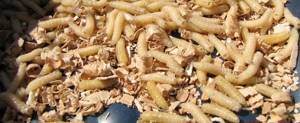
It is not always possible to find the type of maggot that is needed for a particular case in a fishing store, so many experienced fishermen have learned to grow them at home.
It's not difficult at all.
There are many ways to breed maggots at home. Here are the main ones:
How to plant maggots correctly?
The fisherman’s future catch depends on the correct placement of the larvae on the hook, so this issue must be approached with extreme caution and scrupulousness.
If you place a maggot on a hook incorrectly, its insides will leak out, and the individual will have an unsightly appearance for the fish.
With a properly set bait you can catch more than one fish, but even several.
To understand how to place it on a hook without harm to the larva, you need to know the structural features of maggots.
The “head” of the individual is located in the place where the body of the larva is sharper with one dark-colored point.
The back will have two dark dots and will have a blunter end than the front of the maggot.
There are several options for attaching maggots to a hook:
Classic. In this case, the body of the maggot is not pierced. It is fixed on a hook at its back.
This option for fixing the larvae is the most stable of all.
The individual remains alive for quite a long period of time and attracts fish to it. Along the entire length.
By piercing the body of the bait lengthwise, the angler does not allow his future catch to grab the tip of the maggot and remove it entirely or partially from the hook, which significantly reduces the percentage of empty bites and increases the number of fish caught.
Middle nozzle. This option can be divided into two subtypes:
Pierce the larva right through the middle. Place on the skin in the same area.
In both cases, the bait will slowly sink into the water, giving the fish more opportunities to notice it.
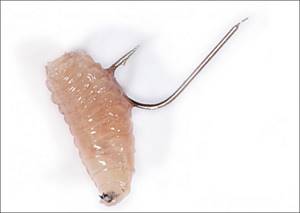
Per head". This option is the most unreliable of all. It is used by fishermen when it is necessary to place two or more maggots on one hook at once.
Each fisherman chooses the bait method depending on what kind of fish he wants to catch and what gear he will use to catch it.
Extraction of maggots for fishing
Maggot is a white blowfly larva. In terms of catchability, in some cases it is not inferior to bloodworms and the same dung worm, but is used by fishermen less often than the above baits.
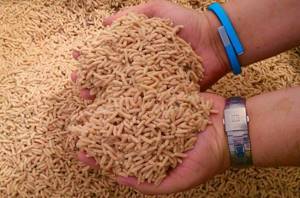
Getting larvae is not that difficult. You can take some amount of meat, or even better if it is the liver or lung of some animal. Deep cuts are made in the meat, and it is hung out in the sun. After a while, many blow flies will fly in and larvae will be laid in the cuts. After being in the open sun for some time, this piece of meat is placed in a container (pot) and closed with a lid. After these actions, after a certain period of time, worms (also called “bubbles”) appear from the eggs, with black dots inside the body.
Wheat bran is added to the container, and within a few days (3-4 days), the maggots acquire the size required for fishing. Then they are transferred to a container, half of which should be filled with wheat bran. Then a certain amount of meat (liver) is added, which serves as food for the larvae. After a few days, the black spots in the bodies of the maggots disappear, they become clean and suitable for fishing.
Read: Features of winter feeding on the river
Some fishermen hang the meat from sticks placed crosswise over a container half filled with dry clay (or bran). The larvae thus fall into the container and burrow.
Also, fish, mainly small in size (bleak, stickleback and others), are perfect for feeding maggots. An open container with fish is placed outside for flies to lay eggs there. Often the larvae become twice as large as ordinary ones. This means that these are maggots from a large blue fly, which are much better suited for bait than regular ones.
Dead maggot for fishing
Sports fishermen often use scalded maggots as bait and as bait. As it turned out, after scalding, the maggot becomes tougher and acquires a bright color. Sometimes fish bite better on such bait than on live maggots.
To scald a maggot, you need to boil water in some suitable container and throw a live maggot into it. The dead maggot floats up and is sent to the bait box. When fishing on muddy bottoms, it is sometimes better to raise the bait so that the fish notice it. This can be done by hanging polystyrene foam on a hook or by attaching scalded maggots.
Scalded maggots are sometimes added to bait balls. They slowly emerge and collect fish in the upper layers. This way you can fish with floats in the upper layers of water.
Another way to lift the larva above the bottom is by inflating it with air using a syringe.
How to clean maggots
Typically, cleaning maggots involves passing the larvae through a layer of dry sawdust. Then they are sprinkled with a mixture of sawdust and flavorings and go fishing.
But passing through sawdust does not clean the maggot from the inside, as can be seen from the dark translucent stripes inside its body. And the outside of the maggot does not become truly clean and is unpleasant to handle.
If you bought poorly cleaned maggots or got them yourself, after superficial cleaning in sawdust, the larvae should be thoroughly washed. It is best to wash in a solution of water and odorless liquid soap. You don’t have to skimp on soap; nothing will happen to the larvae.
After washing in a soapy solution, the maggots should be rinsed several times in clean water and dried in sawdust.
In order for the maggot to be cleared of blackness from the inside, it is placed for some time (3-5 hours) in grated cheese or cottage cheese. This should be done immediately before fishing.
In addition to the fact that the maggot becomes clean, the larvae become more elastic and stay on the hook better.
